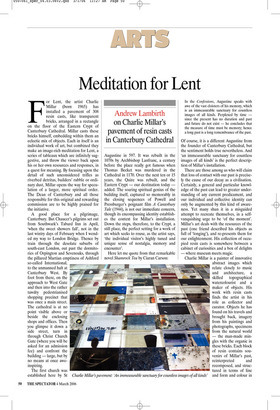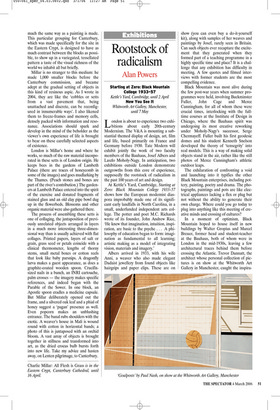Meditation for Lent
Andrew Lambirth on Charlie Millar’s pavement of resin casts in Canterbury Cathedral
For Lent, the artist Charlie Millar (born 1965) has installed a pavement of 308 resin casts, like transparent bricks, arranged in a rectangle on the floor of the Eastern Crypt of Canterbury Cathedral. Millar casts these bricks himself, embedding within them an eclectic mix of objects. Each in itself is an individual work of art, but combined they make an image-rich meditation for Lent, a series of tableaux which are infinitely suggestive, and throw the viewer back upon his or her own resources and responses, in a quest for meaning. By focusing upon the detail of such unconsidered trifles as riverbed detritus, builders’ rubble or ordinary dust, Millar opens the way for speculation of a larger, more spiritual order. The Dean of Canterbury and all those responsible for this original and rewarding commission are to be highly praised for the initiative.
The first church was established here by St Augustine in 597. It was rebuilt in the 1070s by Archbishop Lanfranc, a century before the place really got famous when Thomas Becket was murdered in the Cathedral in 1170. Over the next ten or 15 years, the Quire was rebuilt, and the Eastern Crypt — our destination today added. The soaring spiritual genius of the building itself, captured so memorably in the closing sequences of Powell and Pressburger’s poignant film A Canterbury Tale (1944), is not our immediate concern, though its encompassing identity establishes the context for Millar’s installation. Down the steps, therefore, to the Crypt, a still place, the perfect setting for a work of art which seeks to rouse, as the artist says, ‘the individual visitor’s highly tuned and unique sense of nostalgia, memory and encounter’.
Here let me quote from that remarkable novel Shamrock Tea by Ciaran Carson: In the Confessions, Augustine speaks with awe of the vast cloisters of his memory, which is an immeasurable sanctuary for countless images of all kinds. Perplexed by time since the present has no duration and past and future do not exist — he concludes that the measure of time must be memory; hence a long past is a long remembrance of the past.
Of course, it is a different Augustine from the founder of Canterbury Cathedral, but the sentiment holds true nevertheless. And ‘an immeasurable sanctuary for countless images of all kinds’ is the perfect description of Millar’s installation.
There are those among us who will claim that loss of contact with our past is precisely the cause of our decay as a civilisation. Certainly, a general and particular knowledge of the past can lead to greater understanding of any current predicament, and our individual and collective identity can only be augmented by this kind of awareness. Yet many shun it in a misguided attempt to recreate themselves, in a selfvanquishing urge to be ‘of the moment’. Millar’s art deals with the resources of the past (one friend described his objects as full of ‘longing’), and re-presents them for our enlightenment. His collection of occupied resin casts is somewhere between a cabinet of curiosities and a box of delights — where museum meets magic.
Charlie Millar is a painter of innovative abstract images which relate closely to music and architecture, a skilled topographical watercolourist and a maker of objects. His work with resin casts finds the artist in his role as collector and curator. Objects he has found on his travels and brought back, imagery from his paintings and photographs, specimens from the natural world — the man-made mingles with the organic in these bricks. Each block of resin contains souvenirs of Millar’s past, reinterpreted and recomposed, and structured in terms of line and form and colour in much the same way as a painting is made. This particular grouping for Canterbury, which was made specifically for the site in the Eastern Crypt, is designed to have as much contrast between the blocks as possible, to show up in a variegated, tessellated pattern a taste of the visual richness of the world we inhabit all but briefly.
Millar is no stranger to this medium: he made 1,000 smaller blocks before the Canterbury commission, and became adept at the gradual setting of objects in this kind of resinous aspic. As I wrote in 2004, they are like the ‘cobbles or setts from a vast pavement that, being unattached and discrete, can be reconfigured in innumerable ways’. I also likened them to freeze-frames and memory cells, densely packed with information and resonance. Associations should spark and develop in the mind of the beholder as the viewer’s own experience of life is brought to bear on these carefully selected aspects of existence.
London is Millar’s home and where he works, so much of the raw material incorporated in these setts is of London origin. He keeps bees in the gardens of Lambeth Palace (there are traces of honeycomb in some of the images) and goes mudlarking by the Thames. (Peach stones and bones are part of the river’s contribution.) The gardeners at Lambeth Palace entered into the spirit of the exercise and donated fragments of stained glass and an old clay pipe bowl dug up in the flowerbeds. Blossoms and other organic material were also gathered there.
The process of assembling these setts is one of collaging, the juxtaposition of previously unrelated objects arranged in layers in a much more interesting three-dimensional way than is usually achieved with flat collages. Printed papers, layers of salt or grain, grass seed or petals coincide with a clinical thermometer, lengths of thorny stems, small metal boxes or cotton reels that look like baby parsnips. A dragonfly larva makes a guest appearance, as does a graphite-coated wooden spoon. Crucifixsized nails in a bunch, an INRI cartouche, palm crosses — the imagery makes specific references, and indeed began with the Parable of the Sower. In one block, an Apostle spoon cradles a medicine capsule. But Millar deliberately opened out the frame, and a silvered oak leaf and a phial of honey suggest a ‘pagan’ presence as well. Even popcorn makes an unblushing entrance. The banal rubs shoulders with the exotic. A weaver’s house in Mali is wound round with cotton in horizontal bands; a photo of this is juxtaposed with an orchid bloom. A vast array of objects is brought together in stillness and transformed into art, as the dried crocus bulb bursts forth into new life. Take my advice and hasten away, on Lenten pilgrimage, to Canterbury.
Charlie Millar: All Flesh is Grass is in the Eastern Crypt, Canterbury Cathedral, until 16 April.











































































 Previous page
Previous page